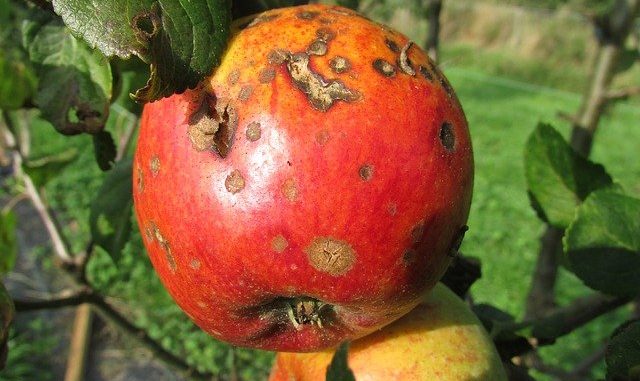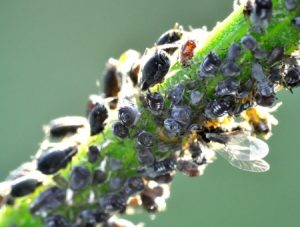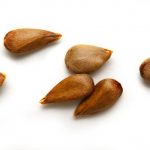
Apple diseases are a real problem. We always hope for a bumper crop of apples if we are lucky enough to have a tree in our garden. However, pests and apple diseases can have quite an impact on reducing our produce. It’s surprising how many insects problems there are affecting apple trees. It is important to know the symptoms of damage they cause to identify the culprit and choose the correct treatment. It is also important to know when to apply the most appropriate treatment to achieve better control.
Aphids
Aphid infestations come and go but they are particularly bad with a warm, often humid summer. Aphids will reproduce rapidly when the temperatures get high and trees develop soft and sappy growth which means a great offering of fluid for many sap-sucking pests. The aphids inject their saliva into the plant stem which contains enzymes that help them suck up the half-digested sap containing their carbohydrates. The plant reacts by its leaves and stems twisting and curling which is the first reaction. The sap is quite sugary and is then excreted back onto the plant. The sap encourages black sooty mould to form.

The worst damage occurs when the leaves and young stems curl up which is a problem for young trees especially as the leader is damaged. On the older trees, damage progresses to the developing fruit. One particular aphid, the Rosy Apple Aphid (Dysaphis plantaginea) causes fruitlets to become more red and twist up. Spring colonies of this particular aphid will often appear on new growth. This aphid leaves apples in summer to feed on plantain, returning in autumn to mate and lay eggs.
To treat any aphid is tricky. Firstly, the aphids need to be spotted which means using a hand lens and monitoring the apple trees fortnightly. The aphids first appear in early May where they travel on the hot air currents whilst their eggs overwinter. Numbers are best reduced with a hand sprayer and such products as neem oil, garlic spray and Piricarb™ work well.
Winter washes should be avoided as they can destroy both the eggs but also the ladybirds that feed on them. However, if you need to apply a winter wash then attempt to treat the eggs in December to January when the tree is dormant and ladybirds are at their least activity. Pesticide sprays are less effective in the spring.
Birds should be encouraged too. Blue tits love aphids so placing nest boxes around the area helps bring them to the trees. Other insects feed on aphids such as lacewings, hoverflies and ladybirds.
One other aphid to note is the Woolly Aphid (Eriosma lanigerum). This leaves white, fluffy deposits on branches and old pruning cuts. Light infestations are best treated by scrubbing off with a coarse brush. Do this before applying a pesticide which usually improves efficacy. Control as soon as colonies appear in spring.
Codling Moths
The Codling Moth (Cydia pomonella) begins to mate in the warm night of early June. Two weeks later the females begin egg laying near the developing fruitlets. The larva is a cream maggot with a small brown head that tunnels into the fruit which is usually at the opposite end to the stalk where the calyx is. It feeds on the apple for up to three weeks. The larva eventually emerges where it becomes a moth in the crevices of the tree trunk. Once the larva has left the apple, the flesh is riddled with burrowing and frass which are the insect’s faeces.
It is difficult to treat for the larva as it is only exposed for a few hours and the moth is nocturnal. Pheromone traps are available to capture the males which reduces the population substantially. Some of these hung about the orchard in late May help immeasurably. Pesticide treatment can be applied if needed from May to June.
The larvae can be trapped as they pupate by wrapping corrugated cardboard around the tree trunks. This is then removed and burnt in late autumn and reduces the damage the following year. Bats however are a good predator, catching the moths on the wing and if all else fails, make cider with the damaged fruit.
Winter Moth
The Winter moth (Operophtera brumata) and other related species is known to be a major issue. The caterpillars eat holes in the leaves, the blossom and developing fruitlets in Spring.
To treat, grease bands are applied around the trunks to stop the wingless females climbing trees to lay eggs. Apple grease bands in October, and maintain through to March.
Scab
The Apple Scab (Venturia inaequalis) is an airborne, fungal disease that affects pome fruit such as apples and pears. It is recognised by the black-brown blotches and spots on both leaves and fruit. The disease appears when conditions are wet and damp. The longer the leaf remains wet, the greater the likelihood of infection. The disease develops in the early season with blotches that cause early leaf fall. This can already limit the fruit crop. Scabby lesions develop on the bark and young shoots which may split. Infected fruit also develop these brown-black spots and patches which form on the skin and eventually crack as the fruit grows. A light infection is not that serious and is only a cosmetic issue.
Scab is best treated by planting resistant apple varieties. The most susceptible include ‘Cox’s Orange Pippin’ and ‘Golden Delicious’ whilst the best are ‘Discovery’, Egremont Russet and ‘Ashmeads Kernal’ amongst many of the older varieties. The other is good housekeeping where best practise in pruning to remove infected wood and maintain good airflow around the trees is needed. Plant trees in open and sunny positions. This reduces the damp micro-climate that forms around the leaves. Scab overwinters as resting spores in fallen leaves which then go onto infect the next year’s growth. Generally, fallen apple leaves need to be raked up in autumn but not composted. Check with neighbours who also have apple trees as they too need employ good practices to avoid cross-contamination. Scabbed apples can be used for cider and juice production but not for storage.
Chemical Control Options
We’ve covered some of the natural predators of many of the insects that damage apples. It cannot be reinforced enough that these are highly valuable in controlling aphids. earwigs are surprisingly good so use pesticides sparingly and never on trees in flower. Spraying may only be possible on smaller trees.
A range of pesticides can be used on apple trees and gardeners must follow manufacturers’ instructions regarding harvest intervals and the maximum number of applications allowed in a given time period.
Pesticides that are considered organic have contact action and may give some control of exposed insects, they can be used up to one day before harvest. These include products based on plant oils and extracts, fatty acids and natural pyrethrum.
Synthetic pesticides based on deltamethrin such as Bayer Provado Ultimate Bug Killer, lamda-cyhalothrin (Westland Resolva Bug Killer) and some formulations of acetamiprid (Bug Clear Ultra) are also available. these products have a 7- to 14–day harvest interval. Plants in flower should not be sprayed due to the danger to pollinating insects.

Leave a Reply